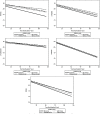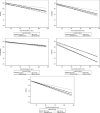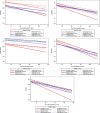Physical Activity and Trajectory of Cognitive Change in Older Persons: Mayo Clinic Study of Aging
- PMID: 33216032
- PMCID: PMC7839815
- DOI: 10.3233/JAD-200959
Physical Activity and Trajectory of Cognitive Change in Older Persons: Mayo Clinic Study of Aging
Abstract
Background: Little is known about the association between physical activity (PA) and cognitive trajectories in older adults.
Objective: To examine the association between PA and change in memory, language, attention, visuospatial skills, and global cognition, and a potential impact of sex or Apolipoprotein E (APOE) ɛ4 status.
Methods: Longitudinal study derived from the population-based Mayo Clinic Study of Aging, including 2,060 cognitively unimpaired males and females aged ≥70 years. Engagement in midlife (ages 50-65) and late-life (last year) PA was assessed using a questionnaire. Neuropsychological testing was done every 15 months (mean follow-up 5.8 years). We ran linear mixed-effect models to examine whether mid- or late-life PA at three intensities (mild, moderate, vigorous) was associated with cognitive z-scores.
Results: Light intensity midlife PA was associated with less decline in memory function compared to the no-PA reference group (time x light PA; estimate [standard error] 0.047 [0.016], p = 0.004). Vigorous late-life PA was associated with less decline in language (0.033 [0.015], p = 0.030), attention (0.032 [0.017], p = 0.050), and global cognition (0.039 [0.016], p = 0.012). Females who were physically inactive in midlife experienced more pronounced cognitive decline than females physically active in midlife and males regardless of PA (p-values for time interaction terms with midlife PA levels and sex were all p < 0.05 for global cognition). APOE ɛ4 carriership did not moderate the association between PA and cognition.
Conclusion: Engaging in PA, particularly of vigorous intensity in late-life, was associated with less pronounced decline in global and domain-specific cognition. This association may differ by sex.
Keywords: Cognitive trajectories; community-dwelling persons; late-life; midlife; physical activity.
Conflict of interest statement
Authors’ disclosures available online (
Figures



Similar articles
-
Physical Activity Moderates the Relationship between Cardiovascular Disease Risk Burden and Cognition in Older Adults.Neuroepidemiology. 2025;59(1):20-30. doi: 10.1159/000536354. Epub 2024 Mar 26. Neuroepidemiology. 2025. PMID: 38531336 Free PMC article.
-
Association of non-exercise physical activity in mid- and late-life with cognitive trajectories and the impact of APOE ε4 genotype status: the Mayo Clinic Study of Aging.Eur J Ageing. 2019 Apr 12;16(4):491-502. doi: 10.1007/s10433-019-00513-1. eCollection 2019 Dec. Eur J Ageing. 2019. PMID: 31798373 Free PMC article.
-
Late-life physical activity, midlife-to-late-life activity patterns, APOE ε4 genotype, and cognitive impairment among Chinese older adults: a population-based observational study.Int J Behav Nutr Phys Act. 2025 Jan 9;22(1):5. doi: 10.1186/s12966-024-01691-7. Int J Behav Nutr Phys Act. 2025. PMID: 39789564 Free PMC article.
-
Physical activity improves cognition: possible explanations.Biogerontology. 2017 Aug;18(4):477-483. doi: 10.1007/s10522-017-9708-6. Epub 2017 May 10. Biogerontology. 2017. PMID: 28492999 Review.
-
Physical Activity, Cognition, and Brain Outcomes: A Review of the 2018 Physical Activity Guidelines.Med Sci Sports Exerc. 2019 Jun;51(6):1242-1251. doi: 10.1249/MSS.0000000000001936. Med Sci Sports Exerc. 2019. PMID: 31095081 Free PMC article. Review.
Cited by
-
Patterns of Factors in the National Institute on Aging Health Disparities Research Framework Domains and Mild Cognitive Impairment Risk.AJPM Focus. 2025 Feb 17;4(3):100324. doi: 10.1016/j.focus.2025.100324. eCollection 2025 Jun. AJPM Focus. 2025. PMID: 40225700 Free PMC article.
-
Development of Modified Japanese Versions of Questionnaires to Assess Physical and Cognitively Stimulating Activities.JMA J. 2025 Apr 28;8(2):498-505. doi: 10.31662/jmaj.2024-0153. Epub 2025 Mar 7. JMA J. 2025. PMID: 40416030 Free PMC article.
-
Effects of MicroRNAs and Long Non-coding RNAs on Beneficial Action of Exercise on Cognition in Degenerative Diseases: A Review.Mol Neurobiol. 2025 Jan;62(1):485-500. doi: 10.1007/s12035-024-04292-4. Epub 2024 Jun 13. Mol Neurobiol. 2025. PMID: 38869810 Review.
-
Physical activity and the outcome of cognitive trajectory: a machine learning approach.Eur Rev Aging Phys Act. 2025 Jan 10;22(1):1. doi: 10.1186/s11556-024-00367-2. Eur Rev Aging Phys Act. 2025. PMID: 39794687 Free PMC article.
-
Physical Activity and Cognitive Decline Among Older Adults: A Systematic Review and Meta-Analysis.JAMA Netw Open. 2024 Feb 5;7(2):e2354285. doi: 10.1001/jamanetworkopen.2023.54285. JAMA Netw Open. 2024. PMID: 38300618 Free PMC article.
References
-
- Kishimoto H, Ohara T, Hata J, Ninomiya T, Yoshida D, Mukai N, Nagata M, Ikeda F, Fukuhara M, Kumagai S, Kanba S, Kitazono T, Kiyohara Y (2016) The long-term association between physical activity and risk of dementia in the community: The Hisayama Study. Eur J Epidemiol 31, 267–274. - PubMed
-
- Tolppanen AM, Solomon A, Kulmala J, Kareholt I, Ngandu T, Rusanen M, Laatikainen T, Soininen H, Kivipelto M (2015) Leisure-time physical activity from mid- to late life, body mass index, and risk of dementia. Alzheimers Dement 11, 434–443 e436 - PubMed
-
- Gaertner B, Buttery AK, Finger JD, Wolfsgruber S, Wagner M, Busch MA (2018) Physical exercise and cognitive function across the life span: Results of a nationwide population-based study. J Sci Med Sport 21, 489–494. - PubMed
Publication types
MeSH terms
Substances
Grants and funding
LinkOut - more resources
Full Text Sources
Other Literature Sources
Medical
Miscellaneous

